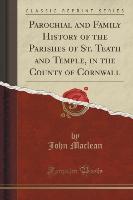- Start
- Parochial and Family History of the Parishes of St. Teath and Temple, in the County of Cornwall (Classic Reprint)
Parochial and Family History of the Parishes of St. Teath and Temple, in the County of Cornwall (Classic Reprint)
Angebote / Angebote:
Excerpt from Parochial and Family History of the Parishes of St. Teath and Temple, in the County of CornwallThis parish rests upon the Devonian series of rocks, and into which protrudes for about half a mile the Elvan dyke, already described, l and a greenstone vein running parallel with it, on the east side, for a somewhat greater distance. There is also another small vein of greenstone running parallel with the river boundary on the east of the parish, and reaching from Treharrick to near Knight's Mill. The argillaceous slates of this parish underlie the grauwack slates and grits of Boscastle and Tintagel, which are beneath the carbonaceous series of North Devon. In several places. Particularly at the celebrated Delabole Quarries, these slates are Of a sufficiently fine grain to be worked as roofing slates, and are superior to any in the district. They are even said by Bishop Watson in his Chemistry to be the very best in England. Interspersed with these are found schistose beds, resembling green stone, which, in some places, so graduate into the slate that the change becomes imperceptible, forming a kind of porphyry. These beds appear to consist of finely comminuted greenstone permitted to settle in water in which calcareous matter was occasionally present. Dr. Boase has observed that the principal mineral substance has a character between hornblend and chlorite. Throughout the Delabole Quarries there are insular patches of the same rock which have not regular foliation, but which break into coarse thick fragments, with a conchoidal fracture. In some places they resemble roofing slate, but in others they contain a considerable portion of a dark green foliated hornblend, similar to that occurring in conjunction with calcareous spar in the rock at Grylls, before described, 2 and a mineral in the form of white streaks of carbonate of lime. This circumstance shews that the slate of Delabole forms part Of the series of rocks to which the calcareous rocks of Grylls belong. The whole may be regarded as one system, the two kinds of trappean rock having, probably, been erupted, one in the state of igneous fusion and the other in that of ash, during the time that the mud now forming slates was deposited.About the PublisherForgotten Books publishes hundreds of thousands of rare and classic books. Find more at www.forgottenbooks.comThis book is a reproduction of an important historical work. Forgotten Books uses state-of-the-art technology to digitally reconstruct the work, preserving the original format whilst repairing imperfections present in the aged copy. In rare cases, an imperfection in the original, such as a blemish or missing page, may be replicated in our edition. We do, however, repair the vast majority of imperfections successfully, any imperfections that remain are intentionally left to preserve the state of such historical works.
Folgt in ca. 5 Arbeitstagen




